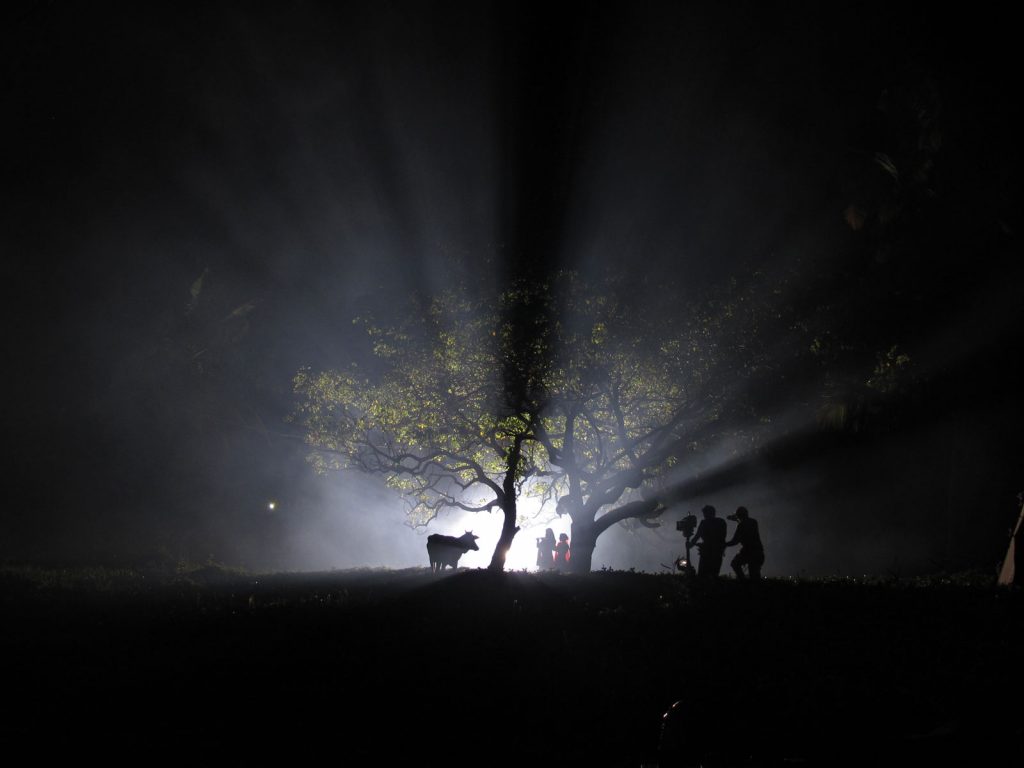It’s day 23 of a 41-day film shoot for Dzongsar Khyentse Rinpoche’s third feature film (working title: Vara). The cast and crew have taken over a small Muslim village near Dambulla, Sri Lanka, graced by fertile rice fields and wide bicycle paths, lotus ponds, and a view of the 5th-century Buddhist rock fortress of Sigiriya. The weather is fine, Bush Warblers and parakeets thrash about in the trees, filling the soundman’s headphones with birdsong, much to his irritation. Today the crew is filming interiors of the house of the lead characters, Vinata and her daughter Lila, temple dancers of the devadasi tradition.
Rinpoche reads the call sheet, a breakdown of tomorrow’s scenes, through pink-tinted sunglasses. “‘Vinata beats Lila.’ Oh my God,” and then he laughs. He’s sitting in a low-slung folding chair in a makeshift tent in the coconut grove behind the house. Someone has climbed up the trees and cut down all the coconuts so there will be no accidents. Coconuts can kill. The divinations have all been positive about the film, but no need to take risks. Screens are set up in the tent for Rinpoche to watch a live feed of the camerawork. People are crouching around his chair, not to glimpse the great vajra master—lineage holder of the teachings of Jamyang Khyentse Wangpo, grandson of His Holiness Dudjom Rinpoche, the supreme head of the Nyingma tradition of Tibetan Buddhism—but to make sure the actors are in frame and the lighting is good.
From the other side of the house, the first assistant director, Stojan Petrov, calls, “Quiet, please! Camera rolling!” Someone else shouts, “Shut da window!” The scene number is called and the clapper is snapped shut. Rinpoche hollers, “Action!”
The film’s star, Shahana Goswami, is fully in character, lost in Lila’s skin as she lies on her bed communing with Lord Krishna. Lila’s devotion is blurring her reality, she’s been seeing Krishna walking in daylight, hidden behind the facade of a low-caste boy named Shyam. “Is it you?” she asks. Despite the beauty of her expression and the seductive curve under her sari, the camera is focused only on her hands.
A minute passes, Rinpoche calls “Cut,” and the spell is broken. Chaos resumes. Rinpoche seems pleased. “I think we’re developing the language of this film: finger fetishes, and over the shoulder, and from behind.” He glances at his producer, Nanette Nelms. “Right, sister?” Nanette nods in agreement. It’s her first feature film after years of working on commercials with directors like Marc Webb and Michel Gondry. The pressure has been extreme; she seems to have absorbed all the tension right out of Rinpoche’s system and into her own. He appears utterly at ease. “Calling people ‘Brother’ and ‘Sister,’ that’s also part of our language, right?” he nudges her.
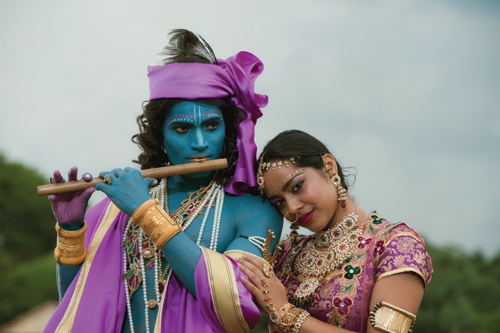
Rinpoche is referring to both the artistic vision and the singular speech of his director of photography, Bradford Young, a Kentucky native who calls Rinpoche “ma brutha,” which seems to amuse Rinpoche endlessly. He was brought in by Nanette, who says, “My first impression of Brad was that he was hyper-intelligent, intense and comfortable with himself and therefore completely, authentically at ease with everyone, which is an incredible asset on set.” Brad’s work on the film Pariah won him the Best Cinematographer award at the Sundance Film Festival in 2011, and Middle of Nowhere, the film he shot for Ava DuVernay, helped her win Best Director at Sundance this year. Brad is smooth with the handshakes, high fives, and friendly arm punches.
What would the 5,000 Tibetan horsemen who greet Rinpoche in Tibet think if they saw this display of affection between this man in a fedora and their vajra master? And for that matter, what would they think of Rinpoche’s outfit—janitor pants he bought at a uniform shop in Japan and a jaunty red bandana?
Rinpoche shot the film Travellers and Magicians in Bhutan in 2002, but on Vara he seems more in charge. His vision is stronger, there is more artistic flow. One of the executive producers, David Urrutia (Meek’s Cutoff, Jesus’ Son), is on set and sees Rinpoche and Brad as an exciting match. “They are feeding each other’s creativity. They are interested in the same things. You see Rinpoche’s artistic vision, but enhanced.”
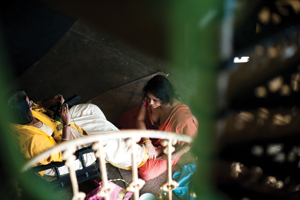
The head of continuity expresses concern about not getting coverage; they haven’t set up any establishing shots, no wide angles. But Rinpoche and Brad are in agreement. Leave it like that. The hands say everything that needs to be said. They share a philosophy that filmmakers cannot worry too much about catering to the audience’s sense of comfort and familiarity.
“Some people are worried I’m being too crazy because I’m not doing close-ups and pick-up shots,” says Rinpoche. “But I just don’t feel like it. On the set, it’s instinct. Trying to insist on sticking to the storyboards ruins the acting, you will miss the atmosphere the minute you go to the close-up. Of course close-ups can be there. But they should be close-ups of other things, independent of the scene, like leaves and a scratching butt.”
Brad calls it creating “courageous frames.” He found his courage for making films at his grandmother’s house. “Maw Maw’s house used to have some really dark, interesting lighting,” he says. “One day on a set I tapped into that; I thought, maybe I’ll recreate that. And I think that’s part of how Rinpoche accesses his own personal narrative. He reflects on things he knows and feels confident about and goes from there. So when our two worlds collide, I feel like we can bring a lot to the table. It’s a mashup. His Bhutanese country monk shit and my Kentucky southern chitlins and collard greens. It’s become both of our stories. I mean, it’s his story, of course. He knows what he wants. His thing is so powerful, all I can do is bring a little nuance. But he’s inspiring me to access my own narrative.”
Rinpoche’s view on Brad is more simply put. “He’s confident and I trust him,” he says.
Someone yells, “Shut da window!” again, and everyone becomes quiet.
“Why does everyone keep yelling ‘shut the window’?”
“It’s Sinhalese. Nishabdavinda, it means ‘Close the mouth.’”
It’s time for a dance sequence. Vinata, played by Geeta Chandran, is guiding her disciples while playing the shruti box (an Indian drone instrument). “Show your devotion to Krishna through the dance,” she instructs them, “strong and confident… just by the spine and the look, establish the naika [the heroine].”
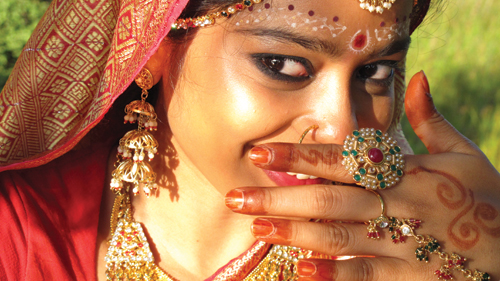
The girls begin moving, rotating on the axes of their perfectly straight backs. Glossy braids and bright fabrics twirling, eyes flashing with wise excitement, they lower their bodies to the floor, making shapes with their limbs like diamonds, standing again in a firm posture, almost scolding, stamping their feet, all the while gesturing with mudras. In the center is Shahana, seamlessly fitting in even though she only began training six months ago. She hits every mark. The girls are breathtaking. It’s no wonder Rinpoche fell in love with the dance.
Geeta-ji and the dancers are all portraying devadasis, or “servants of God,” an ancient Hindu tradition of temple worship whereby girls were given to a temple and married to the deity of that temple, usually a statue or an effigy. They spent their days making offerings of song and dance to the deity, treating the statues as if they were truly their husbands, even dressing them and putting them to bed. In the tradition’s heyday, during the 10th and 11th centuries, kings and communities proudly supported their temples and awarded the devadasis a high social status. The dance was not a form of performance, only worship.
“But there are no more devadasis now,” says Geeta. “The temple as a cynosure of social bonding fell apart in the 19th century. Communities could no longer sustain the devadasis, so rich traders started exploiting them. Because they were so accomplished and so beautiful, they were easy targets. Society’s reaction was to bracket them all together and say they were damned. The tradition went into disrepute. I think the last devadasi passed away a few years back, and I don’t think the tradition will be revived.” This fall from grace interested Rinpoche; it is one of the many subtle themes of the film.
The dance form we’re watching goes back historically to the ancient south Indian classical dance style known as Bharatnatyam, its elements taught and transformed over centuries. In the 1920s and 1930s, there was a sort of Indian renaissance. The few remaining devadasis were sought out and supplicated to teach the dance. “My first 14 years of training were under a true devadasi—Swarna Saraswati had witnessed the whole transition from temple to stage. She was a piece of history, now that I look back,” says Geeta. “But if people say Bharatnatyam is a 3,000-year-old dance, that’s rubbish. The dance you see today is a reconstructed form, keeping the beautiful elements and the essence of the dance so that it suits the stage.” But, she says, “at least veneration is still part and parcel of the dance.”
Aside from Shahana, all the dancers in the film are Geeta’s students from her dance school in Delhi, where she has been teaching Bharatnatyam for the past 20 years. “The dancers are all lovely, so natural,” says costume designer Sujata Sharma, who worked on Monsoon Wedding and Holy Smoke, among many other films. “Their reverence for their teacher is amazing. It’s something to study.” Geeta commands the veneration of her students. It was a challenge for her to dress down for her part as a villager; even Rinpoche was hesitant to ask her at first. She is one of the top dancers in India, and her students are utterly devoted to her. But she saw the film as an opportunity to share classical dance with a wider audience.
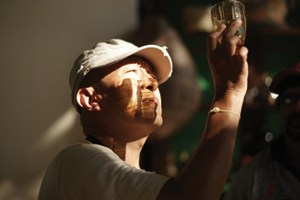
Geeta admires the dancers as they gracefully warm up with effortless knee bends and foot stamps. “They understand the philosophical base, the spiritual content of the dance,” she says proudly. “They understand that dance is not a performing art but something that nurtures the world.”
Rinpoche first encountered Bharatnatyam when he was studying in London in his twenties. In his house in India he has a collection of books and art that convey his love of the dance. And in 2004 he commissioned a choreographer to create a Bharatnatyam dance telling the story of the bodhisattva Manjushri for the inauguration of the Dzongsar Khyentse Chökyi Lödrö College of Dialectics in Chauntra, an event that was attended by H.H. the Dalai Lama and many other great masters. Rinpoche’s love of Indian culture is apparent on the campus of Chökyi Lödrö, which Rinpoche founded to carry on the legacy of a renowned center of nonsectarian learning. The monastery can house up to 2,000 monks and is built around an enormous pillar, a replica of those designed in the 3rd century B.C.E. by the Indian king Ashoka, whom Rinpoche greatly admires. “He was a merciless warlord, and then he renounced war and became a vegetarian and a great patron of Buddhism.”
King Ashoka also had a significant role in bringing Buddhism to the island that is now Sri Lanka. It was Ashoka who sent his son and daughter across the Indian Ocean with a bough of the original Bodhi tree under which the Buddha achieved enlightenment, to be planted in Anuradhapura, Sri Lanka. That tree still lives. The original Bodhi tree eventually died, and the one worshipped today in Bodhgaya, India, actually grew from a sapling of the Sri Lankan tree. Buddhism flourished in Sri Lanka, as it still does. In nearby Aluvihara, the entire Tripitaka was first committed to writing in the first century B.C.E. In Kandy, the Sri Dalada Maligawa enshrines the relic of the Buddha Shakyamuni’s canine tooth, brought by an Indian princess in the 4th century.
Rinpoche says for that reason alone everyone should visit Sri Lanka. “Three countless aeons it took to make that precious body of his, so the least we can do is go visit his tooth.”
There is much to enjoy here. “It’s crazy beautiful,” says Brad. “It’s magical, it’s like fairies live here.” On cue, a flock of peacocks call out from the forest. “Just in this one location all we have to do is change the direction of the camera,” Rinpoche says, gesturing at the obvious bounty of options surrounding him. But it has not all been easy. The country is still getting back on its feet, moving away from decades of civil war and recovering from the devastating 2004 tsunami that killed an estimated 230,000 people. “I think the choice of Sri Lanka will make this film successful, but it’s been paved with obstacles. I am very concerned for this country. And if Sri Lanka goes downhill, Buddhism will suffer. Corruption is everywhere. In hindsight, even with the bureaucracy and bakshish, it may have been easier to shoot in India.” He obviously has much more to say but remains tightlipped. “I could write so many things for Lonely Planet.”
The dancers are panting, and the scene is wrapped. The sun is setting, so it’s time to go back to the hotel. Everyone claps. Brad goes off alone with the camera to shoot the blood-orange sky. Rinpoche goes to his room, shuts his door, and privately does his prayers. As the girls gather their things, their bodies still echo the dance, here a hand gesture, there a graceful bend.
“What is most amazing about this film, to me, is that it is a musical,” says Nanette. “It just seems so unlikely that Rinpoche would make a musical—the fact kind of crept up on me, on all of us, I think. We knew there were musical numbers, but now on screen almost every character is singing or playing an instrument. But then when you look back at the origin of this film, a lot of it has to do with Rinpoche’s love of Indian music and his love of dance, his love of Bollywood.”
One could draw a parallel between certain members of the Vara crew and the young girls who were offered by their parents to the temple gods. Five volunteers here are second-generation students of Rinpoche’s from around the world, and a number of them were offered to Rinpoche as free labor. “My father is very vocal about the fact that he’s offered me and my brother to Rinpoche,” jokes Chime Dorjee, a Bhutanese-Londoner who is spending her gap year working for Rinpoche before taking a job at a law firm. She was given a choice in the matter and leapt at the opportunity to work for him. Rinpoche is very focused on engaging with young Buddhists, guiding the next generation of Buddhist practitioners by relating to them in a uniquely informal manner.
“I feel really lucky. I do. My mom said it’s because of my merit that I get to work here, and I actually feel the same way,” says Joie Chen, who is working as a production assistant and shooting behind-the-scenes footage about the making of the film. She puts her lens on Ed Lin, who was offered by his mother as a camera intern, and asks, “How does it feel to be a donation?”

“I’m happy to be here, and I’ve learned a lot,” says Lin. “But I’m not sure if I’m a good donation or not.”
“I think he’s a great donation,” counters Joie. “He’s like one of those donations that seems like a gag gift but turns out to be so useful even though it still makes you laugh.”
The camaraderie between these two is part of the other on-set choreography, that of the people pouring out their energy to make sure the film happens; it’s a dance of familiarity, exhaustion, affection, intimacy. The crew is like a living multinational organism. There are Bhutanese, Taiwanese, Americans, British, Sri Lankans, Indians, one Korean, a Moroccan. They lean on each other for support, provide much-needed shoulder rubs and sympathetic ears, argue, collude, divide, and fight the good battle for their director.
Rinpoche moves with ease and equanimity through this workspace. He is respected but not feared. When breakfast is finally called in the morning and everyone moves toward the catering tent, he is not offered a cut in the line, it’s first come, first served. His lama status aside, on film sets many directors act like gods, but Rinpoche is taking a strictly socialist approach. He even joked that everyone should have equal status in the film’s credits. “Why does the sound person always come second to the photographer? I think all the credits should be in one frame all at once. Or maybe we should put the craft services right after the name of the film,” he says.
One of his disciples comes to visit the set for a few days. She sits quietly at his feet doing mantras while he works. But in private he asks her not to treat him as a rinpoche in this setting. “I’m not a Buddhist here. If you put me up on a pedestal around other people who are not my students, they won’t know how to handle it.”
“He is just so compassionate,” she says. “He views everything from other people’s point of view. I am learning so much just watching him, just like learning from him when he’s on the throne.”
The majority of the cast and crew have very little idea of the influence and respect Rinpoche has as a spiritual master, and Rinpoche hoped to keep it that way. But Pankaj Pawan, who plays a key role in the film, has been stealing glimpses, watching Rinpoche’s teachings on YouTube. He says he hasn’t been daunted by what he’s seen. “Actors are quite spiritual, so it’s very easy to relate to what he’s saying. An actor has to go within, and that’s what a spiritual seeker does. The more you go within, the more effective your art, the more helpful your art. So I am very impressed.
“The way he is perceived in the outside world is very different than here,” Pankaj adds. “At times we feel like friends and I think, Is this the same Rinpoche who is the one up there on stage in front of a thousand people listening to him?”
On December 27, just days before shooting was to begin, Rinpoche received a message that his father, Dungse Thinley Norbu Rinpoche, had passed away in California. Thinley Norbu Rinpoche was the son of Dudjom Rinpoche and a great Dzogchen master. His passing came as a shock, and the pre-production went into an eerily quiet mode. Back in America, Rinpoche’s six brothers and sisters and an extensive sangha began congregating and making preparations. But if the filming was to be postponed, friends would lose their investment and hundreds of lives would be thrown into chaos. “At the kind of time when he lost his father, his commitment was so strong,” says Geeta. “He said so many people had given their time, so the filming had to go on. He alone went to the States, and in three days he was back. I know it must have been difficult. For us that was quite a lesson. Quite an amazing person.”
A few weeks into the shoot, as they are preparing for one of Lila’s fantasies—Krishna and Radha on a large swing over a lotus pond—Rinpoche takes a moment to dictate a swift rebirth prayer for his father and others. He says:
In the past few years, we have lost some of the greatest appearances of the Buddha, such as Kyabje Trulshik Rinpoche and Mindrolling Trichen Rinpoche and Penor Rinpoche, who were all great reminders. But even though their appearance has dissolved, bear in mind that their compassion does not know the meaning of limitations. In the spirit of “where there is a demand, there is supply,” we should have aspirations and longing for the appearance of the buddhas and bodhisattvas to never cease, and—to put it in a trendy term—for their swift rebirth. But this rebirth should not be limited to a Tibetan child who has been raised in a particular culture or tradition. We can wish for Buddha’s rebirth in all forms, even as something seemingly insignificant as the breeze, to remind us of the values of love and compassion and tolerance.
Most people on the set have no idea that Rinpoche is still fully attending to his religious duties, or even what that entails. Brad has seen a documentary about one student’s view of Rinpoche, called Words of My Perfect Teacher. “That actually doesn’t give you the complexity of his character, though.” He pauses with a grave and knowing look. “At all. But I first knew about him through that, and I thought, Here’s an interesting cat. And then Nanette introduced us and it all came together.”
Stojan—the first assistant director—had no clue who Dzongsar Khyentse Rinpoche was. A Serb native living in India, he’d been on the brink of quitting the film business. After a successful career working on films like The Bourne Identity and The Darjeeling Limited, he was sick of the screaming and yelling most people expected from a person in his position. But then came the call from Rinpoche’s team. He searched the Internet, and after reading the tag line for The Cup (“Buddhism is their philosophy, football is their religion”) he decided to at least have a Skype meeting with Rinpoche. “I had a feeling immediately from the first sentences that this guy doesn’t have an ego.” He took the job.
“Filmmaking is difficult, but you never feel like you are working when you are around him. We went already through some difficult phases and I’ve never seen him worried or unrelaxed. I don’t know how he’s doing it. Working with him is a process; it’s worth looking at how it affects people.” Stojan is already planning to visit Deer Park Institute, Rinpoche’s center in Himachal Pradesh, India, after wrapping. But not until then. “It’s been an amazing experience, but I’d rather finish it and then read his books and learn about his other life, because I just wanted to take this experience as unbiased as possible.”
It’s almost a reversal of the Wizard of Oz story. In this case, everyone is experiencing an ordinary man, unaware of the wizardry on the other side of the curtain.
Others, like Nanette, are working on the film strictly out of totally biased devotion. Although she had a root guru, she found herself looking for a mentor about ten years ago to help her reconcile her artistic pursuits and her Buddhist life. “And then I thought, What about that lama who made that film The Cup?” she says. She managed to meet him at the premiere of Travellers and Magicians at the Buddhist Film Festival in Los Angeles. “I brought him a DVD of The Man Without a Past, and when he started speaking I began to collapse,” she pantomimes a person melting into the ground. “I wasn’t looking for a lama, I had one. But then I was like, Uh-oh!” She was instantly hooked. She offered to help him in whatever way she could but never expected to be tapped as producer of the film. “I always thought I could do something like wash underwear. Not having responsibilities. But here I am.”
If Travellers and Magicians was a grass-is-always-greener tale, Vara is about karma. The laws that bring people together and pull them apart are like a karmic wind that we have very little control over. When Rinpoche was asked to give relationship advice to a youth group in 2010, he laid it out plainly for them: “With relationships you don’t have much choice, when it comes, it comes,” he said. “The only people who have a choice are the sublime beings who have no more karma and no more emotion. Only sublime beings can choose, ‘Today I’m going to have a relationship, maybe tomorrow I’m going to pause the relationship.’ But for people like you and me, we have no control. Even when we think I’ve had enough relationships, I’m not going to have any more—when your karmic wind blows, relationship will come out of nowhere.” Inversely, he says, when you’re at the top of your game, feeling prime for love, “it’ll be dry like a Sahara desert, nothing, no relationship.”
The characters in Vara are very much subjected to these karmic winds. “For love, it can’t be 100 percent reason. It’s not mathematics,” says Pankaj. “Once we start liking, then we find reasons to love.” Pankaj’s character, Prakash, is the shy, soft-hearted village landlord who can’t seem to find a good love match. But on a rainy day, that karmic wind does its thing and in blows
Lila. “My character gets lost in Lila’s flesh,” says Pankaj. Lila, dripping with monsoon rain, squeezing out her sari on the veranda, is no simple girl. Shahana brings to the role a quality that transcends beauty. Like Zeenat Aman from the classic Bollywood film Satyam Shivam Sundaram, she has a changeability, a wildness that makes it hard to look away, especially when she moves. Rinpoche said she doesn’t rehearse much. “Certain people can’t prepare for a scene; they just have what they call emotional intelligence, and that’s Shahana. She’s a chameleon.”
Shahana says that Rinpoche is creating an atmosphere that allows her to take risks. “Usually I come to work with a healthy nervousness for shooting, and now I don’t feel it at all. In a good way. I feel relaxed and I feel energized, but I don’t feel nervous,” she says. “Some of the things I’ve done I couldn’t have dreamed up—like yesterday in the scene when I talk to God, Rinpoche wanted a certain lunacy. I know lunacy and yet I don’t know at the same time. He makes you see the things that he himself focuses on, and it makes you notice them more in life, which is really nice.”
Vara will enter the film festival circuit in the fall of 2012, after visionary editor William Chang (longtime collaborator of auteur Wong Kar-Wai) has had his way with the footage. Rinpoche says Vara is paving the way for his epic and final film—two intertwining tales, one about the life of the Buddha and the other about Xuanzang, the famous Chinese monk and historian who traveled to Nalanda University in the 7th century and brought authentic buddhadharma back to China.
“I’m always thinking about the Buddha,” he says. He adds quixotically, “I don’t know if it will be the next film, but I will make it and then that’s it. Filmmaking is not for me. Or I’m not made for filmmaking.”
The film shoot ends on February 17, and the crew disbands. Rinpoche flies almost immediately to Paro, Bhutan, to attend the two-week cremation ceremony of his father, already in progress. How easily he slips into his other role, back in red robes, on the throne in a shrine room erected in a tent on a mountainside. Ten thousand Bhutanese come and bend for his blessing.
Thank you for subscribing to Tricycle! As a nonprofit, we depend on readers like you to keep Buddhist teachings and practices widely available.
